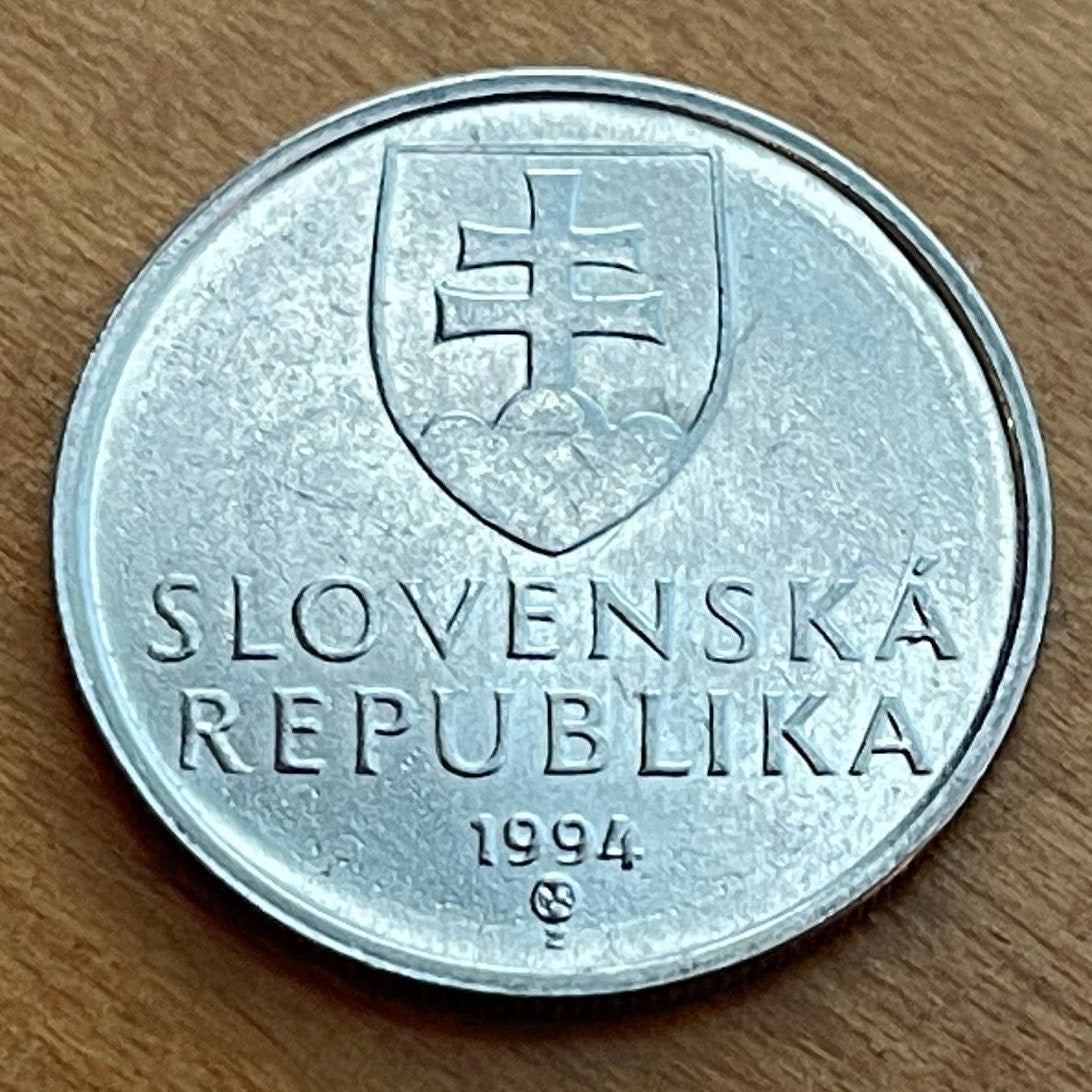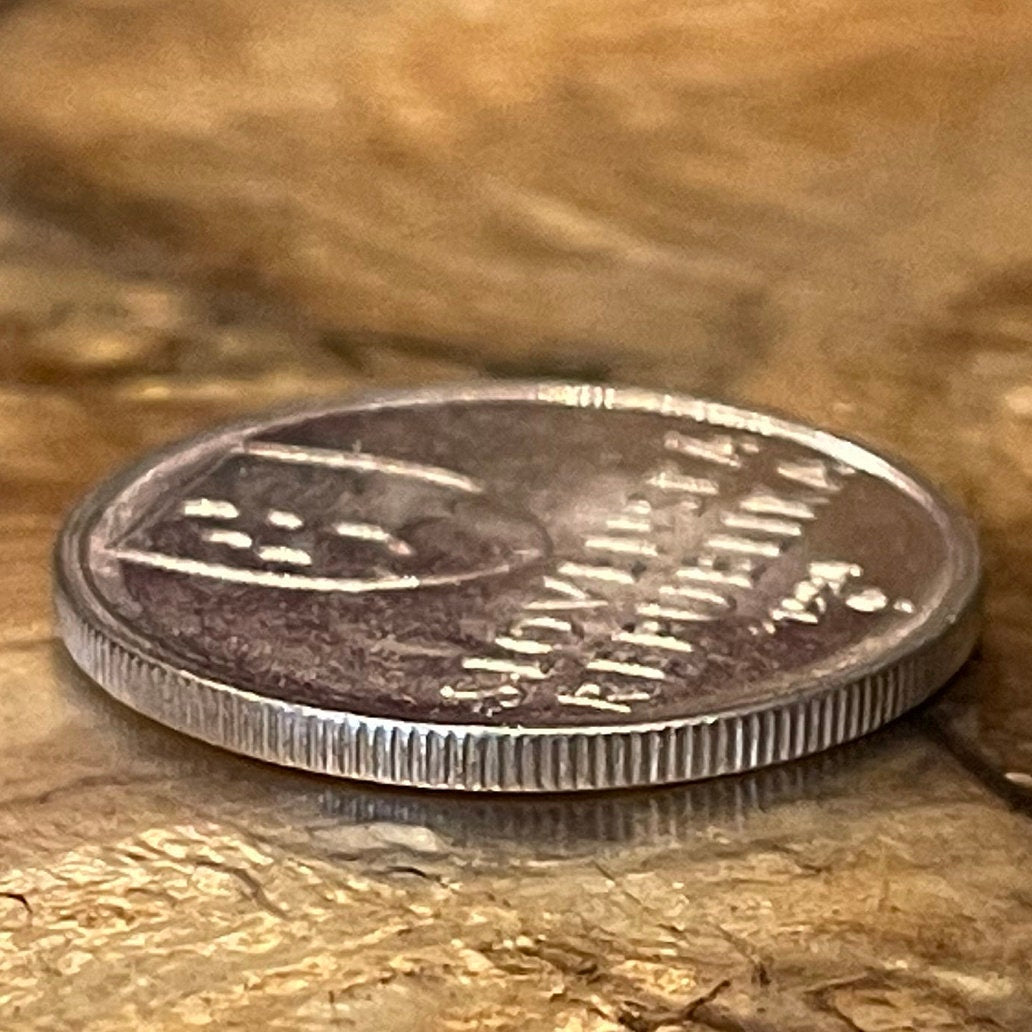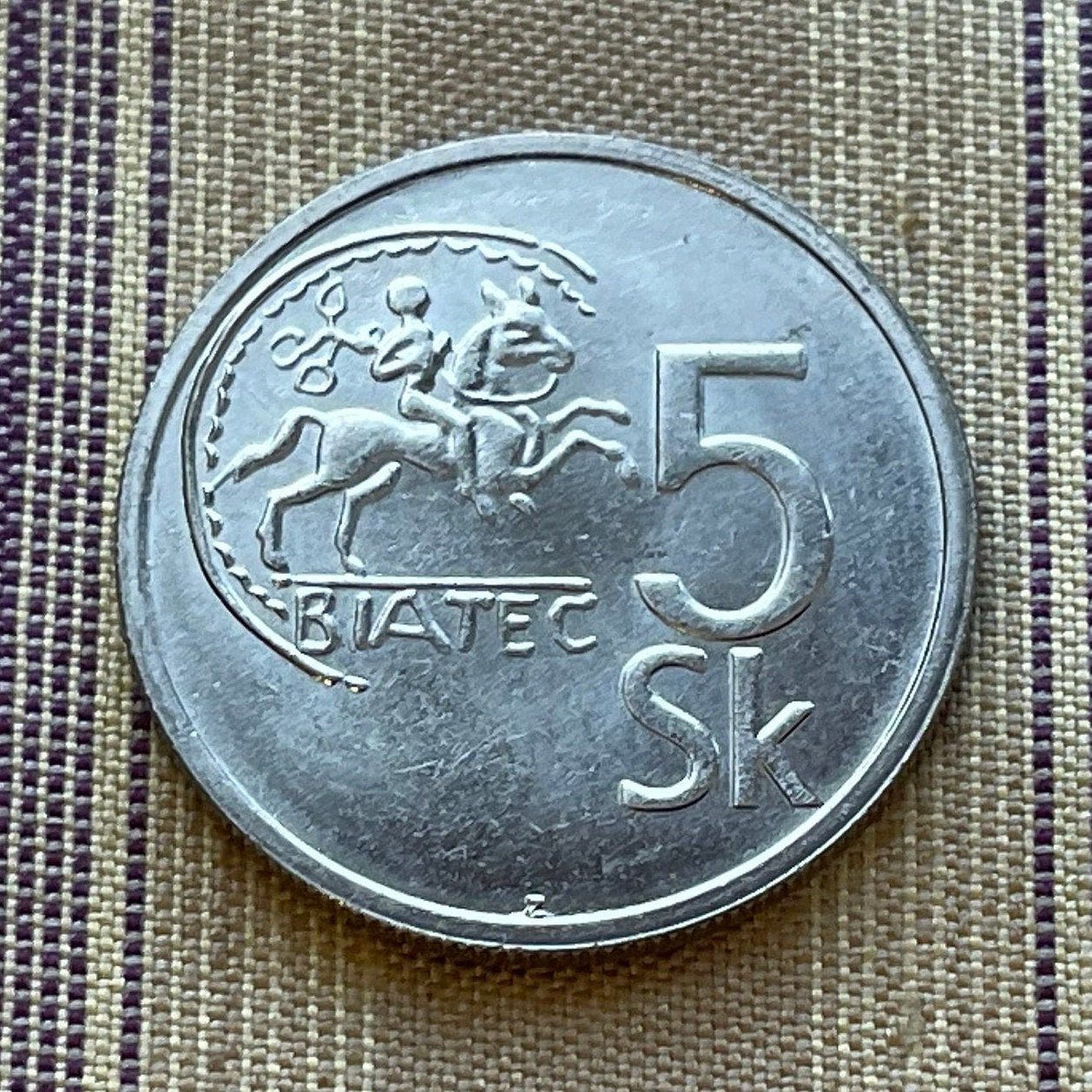elemintalshop
King Biatec on Horse 5 Korun Slovak Republic Authentic Coin Money for Jewelry and Craft Making (Celts) (Celtic Coin)
King Biatec on Horse 5 Korun Slovak Republic Authentic Coin Money for Jewelry and Craft Making (Celts) (Celtic Coin)
Couldn't load pickup availability
King Biatec on Horse 5 Korun Slovak Republic Authentic Coin Money for Jewelry and Craft Making (Celts) (Celtic Coin)
Reverse
Reverse of a Celtic coin of Biatec (Celtic coin from 1st Century AD), depicting warrior on Celticised horse, holding a branch with berries over right shoulder.
Lettering: BIATEC
5 Sk
Obverse: Coat of arms of Slovakia, year of mintage
Lettering: SLOVENSKÁ REPUBLIKA
Translation: Slovak Republic
Features
Issuer Slovakia
Period Republic (1993-date)
Type Standard circulation coin
Years 1993-2008
Value 5 Korún (5 SKK)
Currency Koruna (1993-2008)
Composition Nickel plated steel
Weight 5.4 g
Diameter 24.75 mm
Thickness 1.70 mm
Shape Round
Technique Milled
Orientation Medal alignment ↑↑
Demonetized 17 January 2009
Number N# 2389
References KM# 14, Schön# 17
Wikipedia:
Biatec was the name of a person, presumably a king, who appeared on the Celtic coins minted by the Boii in Bratislava (the capital of Slovakia) in the 1st century BC. The word Biatec (or Biatex) is also used as the name of those coins. In the literature, they are also sometimes referred to as "hexadrachms of the Bratislava type". Biatecs, in fact hexadrachms and tetradrachms made of high quality silver and gold, bear inscriptions in capital Latin letters. Among 14 different inscriptions (for example NONNOS, DEVIL, BUSU, BUSSUMARUS, TITTO), BIATEC appears most frequently. The inscriptions represent the oldest known use of writing in Slovakia and the neighboring territories. The coins have a diameter of 25 millimeters and a weight of 16.5-17 grams. The obverse usually shows various depictions of a head or a pair of heads. The reverse usually shows a horseman, but various mythological and real animals also occur.
Additional Source:
https://archaicwonder.tumblr.com/post/135739632130/celtic-central-europe-slovakia-boii-busu-ar
These types of coins were also known as Biatecs. Biatec was the name of a person, presumably a king, whose appeared on the Celtic coins minted by the Boii in Bratislava (the capital of Slovakia), just like the name Busu appears on the present coin. Biatecs, are in fact hexadrachms and tetradrachms made of high quality silver and gold. Among 14 different inscriptions (for example NONNOS, DEVIL, BUSSUMARUS, TITTO), BIATEC appears most frequently. The inscriptions represent the oldest known use of writing in Slovakia and the neighboring territories. The obverse usually shows various depictions of a head or a pair of heads. The reverse usually shows a horseman, but various mythological and real animals also occur.
The Boii were a Gallic tribe of the later Iron Age, attested at various times in Cisalpine Gaul (northern Italy), Pannonia (Hungary and its western neighbours), parts of Bavaria, in and around Bohemia (after whom the region is named in most languages), and Transalpine Gaul. In addition the archaeological evidence indicates that in the 2nd century BC Celts expanded from Bohemia through the Kłodzko Valley into Silesia, now part of Poland.
They first appear in history in connection with the Gallic invasion of north Italy, 390 BC, when they made the Etruscan city of Felsina their new capital, Bononia (Bologna). After a series of wars they were decisively beaten by the Romans in a battle near Mutina (Modena) and their territory became part of the Roman province of Cisalpine Gaul. Around 60 BC, a group of Boii joined the Helvetians’ ill-fated attempt to conquer land in western Gaul and were defeated by Julius Caesar, along with their allies, in the battle of Bibracte. Caesar settled the remnants of that group in Gorgobina, from where they sent two thousand to Vercingetorix’s aid at the battle of Alesia six years later. The eastern Boii on the Danube were incorporated into the Roman Empire in 8 AD.
*********
Wikipedia:
The coat of arms of the Slovak Republic consists of a red (gules) shield, in early Gothic style, charged with a silver (argent) double cross standing on the middle peak of a dark blue mountain consisting of three peaks. Extremities of the cross are amplified, and its ends are concaved. The double cross is a symbol of its Christian faith and the hills represent three symbolic mountain ranges: Tatra, Fatra (made up of the Veľká Fatra and Malá Fatra ranges), and Matra (in northern Hungary).
Double cross
One of the modern interpretations of the double cross is that it represents Slovakia as an heir and guardian of Christian tradition, brought to the region by St. Cyril and St. Methodius, two missionaries from the Byzantine Empire.
The two-barred cross in the Slovak coat of arms originated in the Byzantine (Eastern Roman) Empire in the 9th century. Unlike the Christian cross, the symbolism and meaning of the double cross is not well understood. One interpretation is that the first horizontal line symbolized the secular power and the other horizontal line the ecclesiastic power of Byzantine emperors. Another that the first cross represents the death and the second cross the resurrection of Jesus Christ. In the Byzantine Empire of the 9th century, the double cross was a political symbol used by Byzantine clerks and missionaries.
The double cross arrived in the territory of current-day Slovakia probably no later than during the 9th century mission of Cyril and Methodius to Great Moravia. Though used frequently in Great Moravia, it was not a state symbol at that time, because there were no state symbols in the modern sense in Europe at that time yet. By means of Zwentibold (the ruler of Lorraine, son of the German emperor Arnulf of Carinthia and godchild of the Great Moravian king Svatopluk I), this symbol got to Lorraine and is called the cross of Lorraine there.
The double cross symbol appeared again in rudimentary features on the first coins that Stephen I, the first king of the Kingdom of Hungary (part of which now forms the territory of present-day Slovakia), had minted at an unknown place. Before he became king in 1000, he was the Grand Prince of the Principality of Hungary and was living there with his Bavarian wife Gisella. The frequent opinion that the double cross was a cross that the Pope granted to Stephen I. around 1000 is still disputed. The opinion arose only in the 15th century based on a legend from the 12th century, which in addition only says that Stephen received an apostolic cross (i.e. a normal, not a double cross).
Share



















